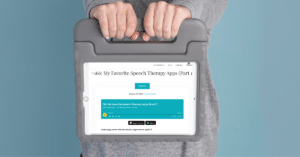When you’re first starting to work with a new student, one of the “go to” assessment tools is a language sample.
But wait…
What if you don’t have time to collect language samples?! Aren’t they incredibly time-consuming?
They don’t have to be!
What is a language sample? Why is it important?
Before we jump in, let’s chat a little bit about why we should even bother with language samples.
Language samples, and particularly narrative language samples, may offer a valid complement or even alternative to norm-referenced testing (Ebert & Scott, 2014).
1. Language samples address many of the weaknesses of norm-referenced testing.
2. They provide rich, in-depth information about a child’s use of language in real-world situations (Costanza-Smith, 2010; Hewitt, Hammer, Yont, & Tomblin, 2005), resulting in strong ecological validity and the ability to derive language treatment targets.
3. They place very few behavioral requirements on examinees, allowing for flexible use across children of diverse ages and types of impairment (Costanza-Smith, 2010).
4. They have been shown to be a valid assessment for diverse populations, including bilingual children (Restrepo, 1998) and speakers of nonstandard dialects (Stockman, 1996).
And guess what?! It doesn’t have to take you hours to analyze your samples.
6 Steps to Streamline Your Language Sample Collection
When documenting my language samples, I wanted some quick and easy data to share. The mean length of utterance (MLU), or the average number of morphemes per utterance, is a quick, easy, and useful measure. Several research studies cite MLU as an “index for language development” (e.g., Condouris, Meyer, & Tager-Flusberg, 2003; Tager-Flusberg et al., 2009). We also know that students with language delays/disorders produce shorter utterances and use fewer grammatical morphemes. We even have some norms that we can refer to when making clinical decisions. (MLU isn’t the only measure we can look at, but it is a very helpful starting point!)
I used to manually count all the morphemes/utterances and pull out a calculator to do the math, but I knew there had to be an easier way! I did some research, and I was able to create a smart spreadsheet that automatically calculates MLU for you!
Here are the steps to use it!
1. Enter Student Information
I typically only include my student’s initials. My school district didn’t purchase the HIPAA-compliant version of Google Drive, so I want to avoid including too much student data.
I also include the date, time, and type of sample collected.
2. Start the Timer
Give the student a prompt (e.g., a conversation starter, a wordless picture book, sequencing cards, etc.) and start typing away!
To calculate mophemes (instead of words), just want to add a space in between every morpheme. For example, “The cats walked across the room” would be “The cat s walk ed across the room.”
I hit “Enter” to move each utterance to a new line.
I usually record the sample so I can refer back to it, if needed.
3. Add Relevant Notes
I make note of anything that struck me in regards to language content, form, or use.
4. Delete Extra Rows
I delete extra rows, so the spreadsheet only calculates the MLU using the student’s utterances.
5. Update the Number of Utterances
I highlight the utterances, and Google Sheets automatically calculates the number for me. I update that number on the bottom of the sheet. (We typically want to shoot for 100 utterances in a language sample.)
6. Language Sample = Complete
Now, it’s time to “plug and chug.” I move the data into my report. Because I took notes in “real time,” it makes it really easy to describe what actually happened during the language sample (rather than guessing…!).
You can also print the sheet to attach to your report.






Leave a Reply